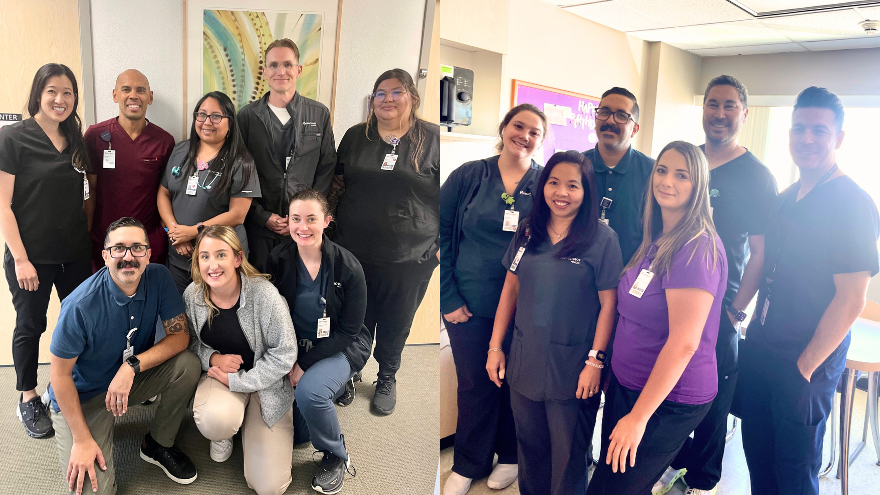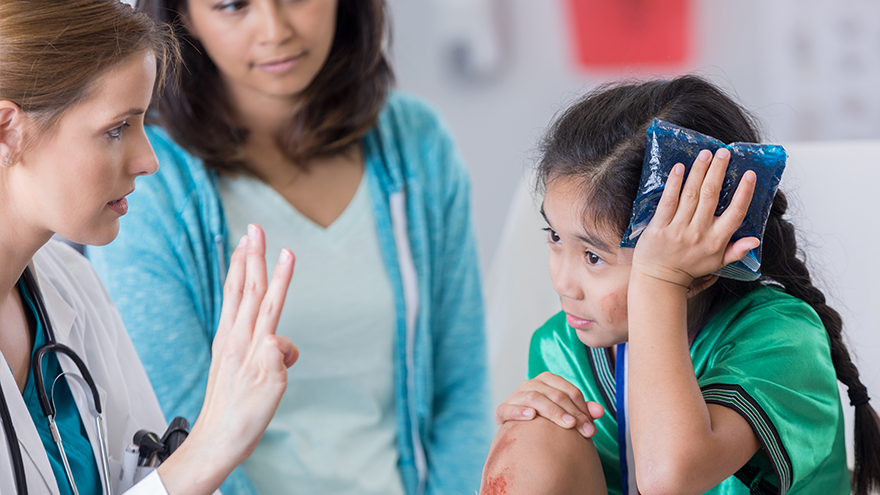Search
-
Department Spotlight: Physiatry
Pain is a top reason that Americans seek access to healthcare. In fact, according to the U.S. Pain Foundation, chronic pain affects nearly 50 million people across the country. More than likely, you know someone who has been impacted by chronic or acute pain. Fortunately, there is a talented team of healthcare professionals committed to rehabilitating and enhancing the life of any patient living with pain. At Renown Health, these team members represent the Physiatry department, who are charged with a goal of maximizing physical function, managing pain and nurturing independence. Headquartered at Renown South Meadows Medical Center, patients suffering with a disability, chronic pain and physical impairments can rest assured that they have the most caring and compassionate physiatry experts on their side throughout the entire physical rehabilitation process. What is Physiatry? Physiatry (also known as physical medicine and rehabilitation, or PM&R), is a medical specialty that helps diagnose and treat conditions related to the musculoskeletal and nervous systems. Unlike other medical fields that often use surgery or medication, physiatry emphasizes non-invasive techniques, therapies and interventional procedures to help with pain and improve physical function. Renown’s physiatry team has a holistic approach to care, combining medical expertise with personalized rehabilitation strategies to support long-term health and independence. Physiatry is hyper-focused on diagnosing, managing and treating conditions that affect physical function and quality of life. The Physiatry Philosophy Our Physiatry team’s treatment philosophy centers around a multidisciplinary approach that combines medical care with rehabilitation and healthy lifestyle changes. They offer a variety of programs and services, including: Home Exercise Programs: Customized exercises designed to strengthen muscles, improve flexibility and support recovery. Physical Therapy: Hands-on care from skilled therapists who guide patients through techniques to restore function and reduce pain. Well-Being and Lifestyle Support: Emphasizing overall health and encouraging lifestyle changes that support physical and mental well-being. At Renown, the Physiatry department is full of friendly faces, including: PM&R and pain medicine physicians (also known as physiatrists) Medical assistants Physician scheduling coordinators Patient access representatives Practice site leaders Physiatrists set each patient up for success with education, treatment planning and management. They take advantage of cutting-edge technologies and interventions for pain, such as: Epidural Steroid Injections (ESIs) Facet Joint Injections Radiofrequency Ablation (RFA) Trigger Point Injections Joint Injections (Knee, Shoulder, Hip) Physiatrists are also masters of multidisciplinary care, coordinating with members of a patient’s healthcare team (including physical therapists) to ensure they have the best treatment plan possible. Playing a crucial supportive role, physiatry medical assistants (MAs) assist our physiatrists in caring for patients on both a clinical and administrative level. From helping during procedures to providing education and guidance, these medical professionals are key in ensuring each patient’s visit – and as a result, their rehabilitation journey – is successful. “My normal day in Physiatry is very smooth,” said Rosita Gans, Medical Assistant. “I make sure my schedule is at 100% to prioritize patient needs. It helps that everyone is so respectful and friendly.” Our patient access representatives (PARs) and physician scheduling coordinators are the front faces of physiatry. They serve as a patient’s first line of communication when checking in, making an appointment, handling insurance verifications and several aspects of follow-up – all with a smile on their faces. “My job as a PAR involves checking patients in and out, verifying their insurance and demographic information, scheduling and following up on appointments, referrals to Special Procedures and more,” said Andrea Ruiz, Patient Access Representative. “I am in contact with patients on a daily basis.” “It’s all about making sure every patient is taken care of in a timely manner,” added Kasey Sinfellow, Physician Scheduling Coordinator. At the core of keeping things running, you’ll find Antonio Quintana, Practice Site Leader. Thanks to his expert leadership skills and can-do attitude, his department has been able to reach new heights. A large part of this team’s success lies in their approach to the practice of physiatry. For them, there is no such thing as a “cookie cutter” treatment plan. Dr. Casey Keating, a pain management physician working with the Physiatry team states, “We understand that there is no ‘one size fits all’ when it comes recovery. We come up with a plan of action customized to meet your needs.”
-
From Patient to PAR: Jodee’s Road to Renown
When faced with chronic pain, that agonizing feeling of dread can be overwhelming to anyone, let alone a cancer survivor. Take Renown Patient Access Representative (PAR) Jodee Elder, for example. As she was receiving radiation treatments while Fighting the Good Fight against cancer, she started to experience pain at the base of her spine that ended up progressing to lower spine arthritis. On top of trying to beat cancer, the last thing she needed to deal with was the intense pain that was affecting her everyday life – and she deserved a solution that was going to provide her with the relief she needed for the long term. That’s where the Special Procedures – Pain Management department at Renown Rehabilitation Hospital – a part of Renown Spine, Sports & Pain Management – stepped in. But the team of doctors, nurses and imaging technologists Special Procedures had more on their minds for Jodee beyond pain relief. As a Renown employee, they knew what a best-in-class PAR Jodee was in her unit at the time, and they wanted that level of passion as the face of their department. Little did they know that Jodee shared the exact same sentiments. From Patient... As a skilled Patient Access team member since 2018, Jodee knows first-hand how important it is to set patients up for success before, during and after an intimidating procedure. She began her Renown career as a Pre-Registration PAR, eventually taking her expertise to Surgical Preadmission. During her years on those two teams, she honed her craft as a personable, patient-facing guide, continually going above and beyond for every patient and employee. But there was one problem: the chronic pain in her lower back that happened as a result of her radiation treatments. This pain ended up being diagnosed as lumbar spondylosis, a degenerative spinal condition that causes arthritis in the back. And when you work a desk job, back pain can be especially excruciating. When 2023 rolled in, Jodee knew she needed to try something new for her pain, something that would give her relief once and for all. After some research and advice from her doctor, she learned about Special Procedures, a team at Renown Rehabilitation Hospital offering pain management options that she wasn’t previously familiar with. Eventually, her care teams discovered that a bilateral radiofrequency nerve ablation may give her the relief she needed. Throughout the entire process, Jodee recalls feeling supported every step of the way with an experience personalized just for her. Despite being nervous at first, she was quickly put at ease by the caring nature of her pain management team. “From scheduling and the pre-operative process to the procedure and recovery experience, I often think about the amazing care I received from the entire team,” said Jodee. “Dr. Casey Keating and the nurses were with me at every point of my procedure. This was such a personal experience. I was treated like I was their only patient for the day, and everyone tried hard to alleviate any anxiety, stress or worries I had by comforting me with things like music, rubbing my leg and one-on-one conversations throughout the process.” Since her procedure, Jodee has been virtually pain-free, happily noting that she hasn’t taken any pain relievers from that day on. She gained a lot of coping skills from her care team that, as fate would have it, would inspire her to help other patients who are preparing for their own procedures. ...To Pain Management Patient Access... Before her first procedure even began, Dr. Keating was already told all about Jodee by a former coworker, who applauded her organizational skills. He very quickly was impressed by her work ethic and experience as a PAR. While she was undergoing her procedure, Jodee couldn’t help but notice how the nurses went above-and-beyond for her and treated her like she was a part of the team – even before they knew her. She immediately felt at home in Special Procedures, not only because of the level of care the team provided but also because of how much her life changed after receiving the much-needed relief for her back pain. “When I came for my first injection, Dr. Keating introduced me to the nurses as ‘the PAR we want over here,’” said Jodee. “I was on the fence regarding leaving my current PAR role, but after my experience with Special Procedures, the team really sold me on the opportunity. I immediately thought, ‘I want to be a part of this.' They were so appreciative of me from the start." And the rest is history. On Nov. 17, 2023, Jodee began her journey as the PAR dedicated solely to Special Procedures. On a typical day, you can find Jodee interacting with patients ahead of time to make checking in more enjoyable, helping patients through the pre-registration process, scheduling our Renown-employed and community providers for each procedure, checking up on authorizations, and of course, leaving a positive impact on everyone she connects with. In addition, she is known as the Special Procedures “chart master” as the main employee organizing each patient’s chart. But her duties as a PAR go beyond the desk. As a former patient herself, she has the unique ability to relate to Special Procedures patients who are worried and anxious about the road ahead. “When nervous patients come in, I can connect with them on a personal level and support them with suggestions that helped me out when I was going through my procedure,” said Jodee. “I love being patient-facing. You wouldn’t believe how many patients we’ve helped enter their procedures calmer than they were before and get the relief they need. I enjoy taking care of these patients – that's why I got into healthcare. I wanted to make a difference.” ...And Beyond Today, Jodee has been a proud PAR in Special Procedures for almost a year. She has thoroughly enjoyed her time with her fellow team members, who have been nothing short of a family to her in more ways than one. “This team is incredibly supportive of me both at work and in my personal life,” said Jodee. “When my mother passed away, they sent me a beautiful flower arrangement and a card that they all signed. The day I came back to work, they all hugged me and said they were always there for me if I wanted to talk. It’s like a big family here.” In her experience as a patient and a PAR, Jodee lives by one main motto: start a chain reaction. As she emphasizes, it only takes one of us to start a chain reaction to affect patients and the community. In Special Procedures, it starts with Jodee. And in life, she tells her kids to be that chain reaction starter. Outside of work, Jodee enjoys spending time with her kids and is happily anticipating the arrival of her grandson, who was conceived very close to the day that her mother passed away. She always makes time to create new memories with her family, including “tattoo roulettes,” where they each put a few tattoo ideas in a hat and pick one at random; they then go out and each get matching tattoos as a testament to their love for one another. “When one life ends, another life blooms,” said Jodee. If you are interested in receiving care with Renown Spine, Sports & Pain Management, speak with your provider about a referral to our specialized team. In the meantime, we encourage you to learn more about navigating your pain management care with Renown Health.
-
Navigating Pain with Renown Spine, Sports & Pain Management
Chances are you or someone you know will deal with chronic pain at some point in life. In fact, in the U.S. alone, one in five adults have experienced chronic pain in recent years, according to the Centers for Disease Control and Prevention (CDC). The road to relief is a frequently traveled one that can be filled with twists and turns, so it’s important for patients to have a trusted provider by their side navigating that journey. We interviewed Dr. Sharlene Su, a pain management physician with Renown Medical Group, who told us what patients can expect when seeking care with Renown Spine, Sports & Pain Management (RSSPM) and all about the variety of pain relief options available to patients. What pain management treatment options are available outside of painkillers? This depends on someone’s root cause of pain. For example, for pain from arthritis of the spine or major joints, radiofrequency ablation can relieve most of the pain for six months to two years, which can be life changing. If someone is suffering from a pinched nerve in the neck or back, an epidural can be useful. Nerve stimulators can also be a great option to relieve pain for years. One of the advantages of the procedures we perform at RSSPM is that they reduce the need for painkillers, which are notorious for having side effects of their own. Physical therapy can also be a very helpful tool to treat pain. It is an exciting time in the field of pain medicine right now because new advances are -constantly being made. At Renown, we pride ourselves on staying current with the most cutting-edge treatments to ensure our patients always have the best available to them. What are some at-home tips and tricks that patients experiencing pain can do on their own for some relief? If pain is related to posture or physical activity, consider doing stretching and strengthening exercises. YouTube can be a great (and free) resource for this. In terms of medications, over the counter topical pain creams can be great. Tylenol is one of the safest pain medications for those without preexisting liver conditions. On a short-term basis, anti-inflammatory medications can often be used safely depending on one’s overall health. Ice and heat can both be useful for treating muscle pain. Can you tell us more about the services Renown Spine, Sports & Pain Management offers? Our team specializes in identifying the root cause of each patient’s pain and partnering with them to develop a custom plan tailored to their individual needs, which can involve injections, physical therapy and medications. We treat patients ranging from top-level athletes, to weekend warriors, to grandparents who’d like to be able to keep up with their grandkids. Once we relieve a patient’s pain, our role then transforms into a coach, educating and guiding our patients on how to prevent their pain from coming back. At RSSPM, you’ll see the same doctor every time, which means that your provider will get to know you very well, and you’ll receive the same high-quality consistent care whenever you come for a visit. Renown has a unique pain management team called “Special Procedures” that not many people may realize is a great option for care. How does this team treat pain? Our Special Procedures team is crucial to the high-quality pain management care that we provide. We have an amazing staff that assists with X-ray guided procedures including epidurals, radiofrequency ablations, joint injections and nerve stimulators. Dr. Casey Keating, our division chief, and I work with this team to ensure that every procedure is done with the same precision, attention to detail and quality. The Special Procedures team regularly receives feedback from patients on how well taken care of they felt during their procedure. If someone is experiencing pain from an injury or even an unknown reason, what should they do to get care for their concerns? Contact your primary care provider for a referral to have an evaluation with us! RSSPM accepts most insurance plans and are proud that our wait times are averaging less than one week to be seen as a new patient. Two more doctors will be joining us in the next few months, which should reduce our wait times even more. There are so many targeted and effective ways to treat pain nowadays, and it is worth addressing to live the life you want to live.
Read More About Navigating Pain with Renown Spine, Sports & Pain Management
-
Department Spotlight: Special Procedures
Chronic pain can be one of the most distressing feelings someone may encounter – and more likely than not, you know someone who is managing their pain as a part of their healthcare journey. In fact, according to the Centers for Disease Control and Prevention, about 1 in 5 U.S. adults have experienced chronic pain in recent years. One of the most common methods of treating pain is through prescription pain medications; however, with the rise of the opioid epidemic across the country, leveraging other interventions to help patients manage their chronic pain has become increasingly more important. What if there was a way to treat pain directly without the automatic need for pain medication? Luckily for patients in northern Nevada, our Special Procedures department at Renown Rehabilitation Hospital specializes in exactly that: interventional pain mitigation sans painkillers. With nearly 95% of their patients who come in with pain-related mobility issues being able to physically walk out of the hospital after their treatment, much-needed relief is clearly in store. Tight-knit and forever-caring, the Special Procedures team knows how to transform the purpose of pain management. A Penchant for Pain Alleviation Renown's Special Procedures team offers a wide variety of pain management solutions that are uniquely tailored to each individual patient’s needs. With the help of a team of 14 attentive nurses, interventional radiology technologists and a surgical technician – plus a dedicated patient access representative ensuring everything goes smoothly behind-the-scenes – these lifechanging interventions include: Epidurals (including steroid epidurals) Nerve blocks Ablations Tenotomies Spinal cord stimulator trials Peripheral nerve stimulator trials The nurses on this specialized team guide patients before, during and after their procedures, making sure they are at ease throughout the entire process. Each nurse emulates both expertise and empathy to help light the path towards healing. “Before each procedure, we get the patient’s vitals, health history and work with the doctor to answer any questions they may have about what is going to happen in the procedure room,” said Michon Edgington, RN. “After they’re all done, they come back to me, and I make sure they are ready to go home by educating them on their discharge. Our goal is to get them back to their families very quickly.” “In the actual procedure room, we perform safety checks, do charting, prepare the sterile tray for the doctor and give medication for conscious sedations, all while consistently monitoring the patient and helping the doctor out along the way to help the procedure go well,” added Shannon Boelow, RN. This team’s dedicated imaging professionals harness expertise that goes beyond capturing images. Their skillful utilization of X-ray technology serves as a guide for doctors administering treatments for pain – and according to our own physicians, our imaging technologists are some of the best in the business. “Our X-ray skills here are specialized,” said Julie Smith, Imaging Lead. “Visually, the doctor needs to see what’s going on inside the body so they can accurately place needles and steroids. We all work together collectively and work with each doctor to accommodate their preferences, helping the treatments go much faster and minimizing the patient’s exposure to radiation.” Serving as the ideal representation of both precision and support, the surgical technician on this team is an important collaborator in the procedure room, helping to ensure the success of every interventional procedure with a meticulous eye for detail. “As the Special Procedures surgical technician, I get the room ready with all the necessary instruments, including making sure everything is sterile,” said Carrie Crow, Surgical Technician. “I enjoy keeping the team organized.” Overseeing it all are the physicians, who are eternally grateful for the team for the life-changing interventions they offer every day. “Our physicians are so phenomenal,” said Brittney Summerfield, Manager of Nursing. “They are very supportive and collaborative, and they always do the right thing. They have total confidence in us.” Seeing patients walk out of the hospital happy and healthy is a driving motivator for this team. Whether they had significant experience in pain management or were ready for a completely new challenge, each team member comes to work every day inspired to move mountains. “I had worked in pain management in other facilities, and I was extremely excited to come here and solely focus on pain,” said Jodi Eldridge, Supervisor of Special Procedures. “I enjoy seeing the patients so happy when they leave no longer in pain. I feel immediate gratification, because you truly feel like you’re doing something big for the patient. It’s very rewarding.” “I decided to come work here because I worked in the inpatient setting for a long time, and I was ready to see a different side of healthcare and provide a different type of care to our community; plus, my coworkers are the best,” added Lisa Dunnivant, RN. There’s no question that the realm of pain management is a delicate one – and there is no team better suited to take on that challenge than Special Procedures, working harmoniously to bring relief and a renewed sense of livelihood for every patient they serve. “Some people believe pain management is just all about pills, and that is simply not true,” said Carrie Crow. “Our procedures are yet another way to help them manage their pain and find relief.”
-
Guide to Injury Healing: Heat or Ice?
Heat and ice are two of the most common treatments used to relieve pain and reduce swelling in injuries. However, each one is better suited for certain types of injuries Dr. Luis Palacio, MD explores the differences between the two. When it comes to treating aches and pains, the debate between heat and ice has been ongoing for quite some time. Both have their benefits making it crucial to understand which option is better suited for your specific needs. Determining which method is better depends on various factors such as the type of injury or pain you are experiencing. For instance, if you have recently sprained your ankle or pulled a muscle during exercise, applying ice within the first 48 hours can help minimize swelling and alleviate discomfort. It's worth noting that some individuals find alternating between heat and ice therapy beneficial as well. This approach combines the benefits of both methods by using heat to increase blood flow followed by ice to reduce inflammation. Cold Therapy Cold therapy can help to reduce inflammation after an injury, heat can have the opposite effect. Therefore, heat therapy should be reserved for those who have chronic pain issues and are not dealing with an acute injury. Cold therapy is often recommended immediately after an injury or during the initial stages of inflammation. Cold therapy such as ice packs are especially effective in treating: Sprains Strains Any injury that involves swelling Heat Therapy Heat therapy is known for its ability to relax muscles, increase blood flow and soothe pain. It is often used for chronic conditions or injuries that are not inflamed. Applying heat can help alleviate stiffness, promote healing and provide a comforting sensation. This increased circulation can bring more nutrients and oxygen to the area, helping it to heal faster. Heat therapy such as heating packs are especially effective in treating: Stiffness with associated pain Injuries that are not inflamed Muscle pain
-
Why Your Teen Athlete Should See a Sports Medicine Doctor
Seeking specialized care for your teen from a sports medicine doctor is essential. Like a coach fine-tunes a player's skills, our experts fine-tune your teen's health, ensuring they stay at the top of their game. Luis Palacio, MD, a sports medicine physician with Renown Health, shares information to help young athletes safely push their boundaries and achieve their personal best. The Role of Sports Medicine Sports medicine is a specialized branch of healthcare that focuses on preventing, diagnosing and treating injuries related to physical activity and sports. Renown's Sports Medicine team consists of skilled professionals passionate about keeping young athletes performing at their peak while minimizing the risk of injury. With a comprehensive approach to care, our sports medicine doctors provide tailored guidance and solutions to help your teen reach their full potential. Injury Prevention and Education Prevention is the key to maintaining a long and successful athletic journey. Our sports medicine doctors collaborate with young athletes to educate them about proper warm-up techniques, body mechanics, and techniques to prevent overuse injuries. From understanding the importance of rest days to practicing correct form, our experts empower teen athletes with the knowledge they need to stay in the game.
Read More About Why Your Teen Athlete Should See a Sports Medicine Doctor
-
Head Injuries, Sprains and Broken Bones
Participating in sports and physical activities is enjoyable and beneficial for our health. However, the risk of injuries comes with the fun and excitement of sports. Sports-related injuries, including sprains, traumatic brain injuries and broken bones, are more common than we realize and can land you in the emergency room. Dr. Scott Shepherd, Emergency Medicine Physician, provides a wealth of information. Traumatic Brain Injuries: The Invisible Threat Traumatic brain injuries come in many forms. From “mild” brain injuries, concussions, to major brain injuries and bleeds. Sometimes it is very difficult to tell the difference between a major injury and a minor injury because many of the symptoms are the same. Concussions Concussions are a type of “mild” traumatic brain injury resulting from a blow to the head or a violent shaking of the body that causes a transient alteration in mental function. They are particularly prevalent in contact sports such as football, soccer and boxing. A concussion can affect memory, judgment, reflexes, speech, balance and muscle coordination. Typically, concussions are not life threatening and usually short lived. However, multiple concussions can lead to permanent disabilities. So, remember there is nothing “mild” about injuring your brain. Contusions The more serious brain injuries from brain contusions (actual bleeding in the brain material) and bleeding that presses on the brain are life threatening. These injuries are caused by the same blow to the head as a concussion and the symptoms are the same from memory deficits, loss of coordination to coma. Because of this, anyone who has a blow to the head and is not acting normal should be evaluated by a medical professional. Anyone suspected of having a severe head injury should seek immediate medical attention and follow a strict protocol for rest and a gradual return to play. It is important to note a person may not lose consciousness if they suffer a concussion; however, major consequences can occur if not properly managed. If you suspect you have an emergency that needs immediate medical attention, please call 911 or visit an emergency room near you. While it is impossible to prevent traumatic brain injuries altogether, the severity of the injury can be mitigated through proper helmet usage and knowing your skill level when participating in high-risk activities. The guidelines for picking a helmet for summer activities such as mountain biking, dirt biking and riding off highway vehicles are similar to those of picking a helmet for winter sports. Learn more about choosing the right helmet. Any blow to your head, neck or upper body can result in a major head injury Signs to watch for include the following: Headache Dizziness Blurred vision Difficulty with thinking, attention or memory Sensitivity to noise or light Ringing in the ears Changes in hearing Double vision Changes in behavior Balance issues Nausea/vomiting Sprains: The Annoying Twist One of the most common sports injuries is a sprain, which occurs when ligaments that connect bones are stretched or torn. Sprains typically occur in joints, such as the ankle, knee or wrist, and are often caused by sudden twists or impacts. Symptoms may include: Pain Swelling Bruising Limited range of motion Rest, ice, compression and elevation (RICE) are the initial recommended treatment, followed by physical therapy to regain strength and mobility.
-
Concussion Risks and Prevention
It’s important to be aware of the risk of a concussion, which can have serious health implications. Susan Park, MD, discusses the effects of concussions and how they can be prevented. According to Susan Park, MD, a Renown Medical Group doctor who specializes in sports and family medicine, concussions are a serious issue — especially among children whose developing brains “are more susceptible to brain injury and long-term effects from concussions.” All parents, coaches and athletes, she points out, should be aware of the risks of concussions and take precautions to avoid them. What is a concussion and how does it occur? Dr. Park describes a concussion as a traumatic brain injury resulting from direct or indirect impact to the head or body, during which the brain shakes back and forth in the skull. This may cause some bruising of the brain. In severe cases, traumatic head injuries can cause bleeding, which if not treated quickly, can be fatal. What are the health implications of a concussion? Symptoms of drowsiness and confusion can be a sign of a concussion after a head injury. Some short-term effects may include headaches, dizziness and difficulty concentrating. Long-term concerns can further include mood disorders, sleep disturbance and problems with cognitive function-concentration, which may affect school performance. What sports carry the highest risk of suffering a concussion? Dr. Park notes participation in any impact sport can result in a head injury. But among school-age kids, she treats more concussions from football and soccer than any other sport. However, during the winter months, skiing and snowboarding injuries can be a common cause of concussions Any blow to your head, neck or upper body can result in a concussion with symptoms including, but not limited to, feeling dazed or confused, dizziness, nausea/vomiting or a headache. Initial treatment of concussions varies depending on severity. Rest, avoiding vigorous activity and a reduced school workload help young athletes recover after a concussion. Dr. Park notes that sometimes further imaging and an ER visit will be required. Otherwise, rest from activities is the main treatment, along with not returning to sports activities until further clearance from a healthcare provider.
-
When Is It Time to See a Physiatrist
Physiatry (fi-zahy-uh-tree), also referred to as physical medicine and rehabilitation, encompasses the diagnosis, prevention and treatment of disabilities or injuries related to the brain, nerves, bones and muscles. The goal of this specialty is to maximize physical functioning, greatly decrease or eliminate pain, foster independence and improve quality of life for those suffering with a disability, chronic pain and physical impairments. Who Is It for? Physiatry can help patients with functional deficits and secondary medical conditions as a result of the following: Amputation Brain Injury Osteoarthritis Spasticity and Movement Disorders Spinal Cord Injury Spine Pain Sports-Related Injuries Stroke Some of these medical conditions can often cause chronic pain or impede physical functioning, ultimately affecting a person’s overall well-being and making it difficult for them to sustain a desired quality of life.








